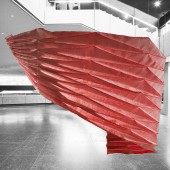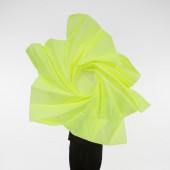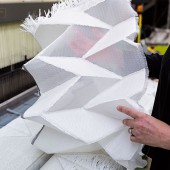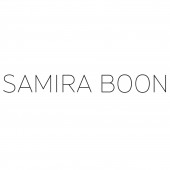Archi Folds Multifunctional Textile by Samira Boon |
Home > Winners > #64605 |
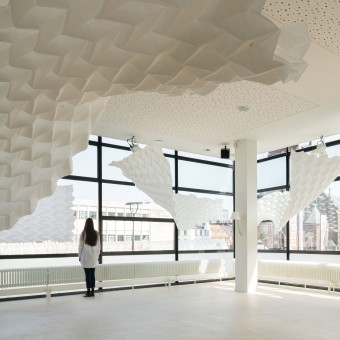 |
|
||||
| DESIGN DETAILS | |||||
| DESIGN NAME: Archi Folds PRIMARY FUNCTION: Multifunctional Textile INSPIRATION: Archi Folds are inspired by the potential of Japanese origami techniques in architecture as a solution for flexible spatial usage. Paper folding translated into digital weaving process leads to this new structural textile. Archi Folds dynamically alter their shape facilitating new situations, spatial circulation, efficient energy usage and acoustic ambience ultimately well. They enable buildings to remain functional for longer and fulfill their potential when owners and functions change. UNIQUE PROPERTIES / PROJECT DESCRIPTION: Archi Folds pioneer on the market of dimensional textiles as a smart material able to form itself due to its complex inner structure. Inner tensions preprogrammed and weaved within the material turn it into fabric muscles or alive origami. Space enhanced by Archi Folds is temporal as it morphs redefining itself in resonance to human and environmental factors. These influences lead to a constant metamorphosis and make material and space feel alive establishing emotional connection with the user. OPERATION / FLOW / INTERACTION: Archi Folds is a strong spatial gesture at the same time easily transported or moved thanks to their compact fold. The woven structures can be unfolded into a myriad of different shapes due to their structural flexibility, allowing two identical products to be installed in completely unique manners, re-used in different shapes and sizes. PROJECT DURATION AND LOCATION: The research started in 2013 In Tilburg Textile Lab. First samples were on show at Building with Textiles exhibition from September 2014 in Tilburg Textile Museum. Phase 2 was on show at Co-Creation exhibition from January 2016 in Tilburg Textile Museum. Market ready Archi Folds were first installed in April 2017 in Tilburg Theatres. They were exhibited and presented at Lexus events in November 2017 and January 2018 in the Louwman museum, The Hague. |
PRODUCTION / REALIZATION TECHNOLOGY: The uniquely developed computational weaving process results into authentic materialization and innovative origami structures. They fold themselves following the tension lines of the interwoven pattern. Within the series we alter composition of the material to create a wide range of possibilities with the textile and fulfill site-specific requirements such as: transparency, stiffness/softness, reflection, light fastness, weight, acoustic, heat-sensitive. SPECIFICATIONS / TECHNICAL PROPERTIES: Standard material width is 1.2 or 2.4 meter. Maximum length is 20 meter. Our technique allows creating unique pieces in form, size and material composition. Our fabrics meet flame retardant standard M1. TAGS: Digital origami weaving technique, architectural textile, interactive environment, flexible space, acoustic space, sculptural interior, dynamic architecture, natural system, 3d textile, alive structure RESEARCH ABSTRACT: Computerized origami materialization results into better specs and longer lasting products in comparison to manual folding and paper. The first step towards creating the digital textile structures on the weaving machine was to understand the folding techniques themselves, which led the designer to Japan to study ancient origami folding techniques. Later applying folding expertize into parametric design was studied together with the programmer. Designs were optimized via tentative prototyping. CHALLENGE: The main challenge was to develop the parameters for the digitally programmed weaving technique. An added difficulty was recreating contrasting features any folding structure requires: soft folds versus hard surfaces. The technique is mimicked in textile structures by applying varying tension to the fold lines in the textiles. Up scaling for architectural applications required many structural optimizations. We also altered material composition to meet flame retardant standards. ADDED DATE: 2018-02-21 11:23:06 TEAM MEMBERS (4) : Designer: Samira Boon, Programmer: Stef Miero, Technician: Michiel Leermakers and IMAGE CREDITS: Image #1: Photographer Ossip van Duivenbode, Theaters Tilburg, 2017. Image #2: Photographer Ossip van Duivenbode, Theaters Tilburg, 2017. Image #3: Illustration Studio Samira Boon, ARCHI FOLDS, 2016. Image #4: Photographer Josefina Eikenaar, ARCHI FOLDS, 2016. Image #5: Photographer Josefina Eikenaar, ARCHI FOLDS, 2016. PATENTS/COPYRIGHTS: Copyrights belong to Samira Boon, 2017. |
||||
| Visit the following page to learn more: http://samiraboon.com/ | |||||
| AWARD DETAILS | |
 |
Archi Folds Multifunctional Textile by Samira Boon is Winner in Textile, Fabric, Textures, Patterns and Cloth Design Category, 2017 - 2018.· Read the interview with designer Samira Boon for design Archi Folds here.· Press Members: Login or Register to request an exclusive interview with Samira Boon. · Click here to register inorder to view the profile and other works by Samira Boon. |
| SOCIAL |
| + Add to Likes / Favorites | Send to My Email | Comment | Testimonials | View Press-Release | Press Kit |
Did you like Samira Boon's Textile Design?
You will most likely enjoy other award winning textile design as well.
Click here to view more Award Winning Textile Design.



